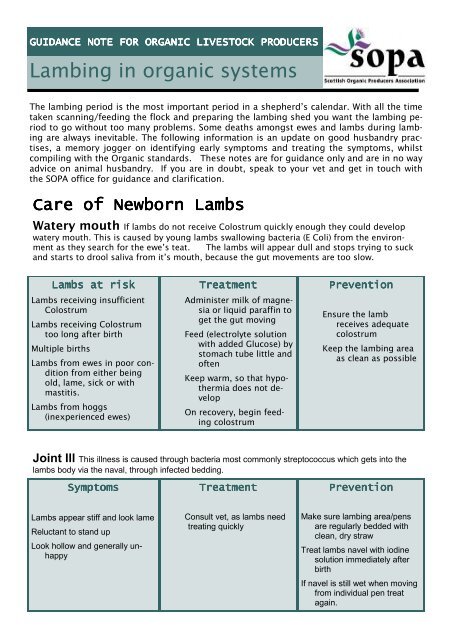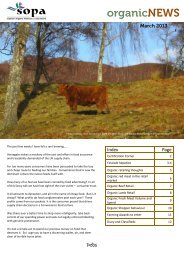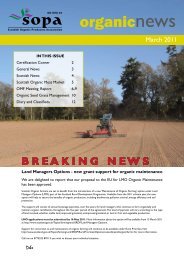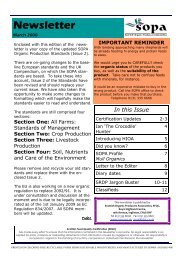Lambing in organic systems
Lambing in organic systems
Lambing in organic systems
You also want an ePaper? Increase the reach of your titles
YUMPU automatically turns print PDFs into web optimized ePapers that Google loves.
GUIDANCE NOTE FOR ORGANIC LIVESTOCK PRODUCERS<br />
<strong>Lamb<strong>in</strong>g</strong> <strong>in</strong> <strong>organic</strong> <strong>systems</strong><br />
The lamb<strong>in</strong>g period is the most important period <strong>in</strong> a shepherd’s calendar. With all the time<br />
taken scann<strong>in</strong>g/feed<strong>in</strong>g the flock and prepar<strong>in</strong>g the lamb<strong>in</strong>g shed you want the lamb<strong>in</strong>g period<br />
to go without too many problems. Some deaths amongst ewes and lambs dur<strong>in</strong>g lamb<strong>in</strong>g<br />
are always <strong>in</strong>evitable. The follow<strong>in</strong>g <strong>in</strong>formation is an update on good husbandry practises,<br />
a memory jogger on identify<strong>in</strong>g early symptoms and treat<strong>in</strong>g the symptoms, whilst<br />
compil<strong>in</strong>g with the Organic standards. These notes are for guidance only and are <strong>in</strong> no way<br />
advice on animal husbandry. If you are <strong>in</strong> doubt, speak to your vet and get <strong>in</strong> touch with<br />
the SOPA office for guidance and clarification.<br />
Care of Newborn Lambs<br />
Watery mouth If lambs do not receive Colostrum quickly enough they could develop<br />
watery mouth. This is caused by young lambs swallow<strong>in</strong>g bacteria (E Coli) from the environment<br />
as they search for the ewe’s teat. The lambs will appear dull and stops try<strong>in</strong>g to suck<br />
and starts to drool saliva from it’s mouth, because the gut movements are too slow.<br />
Lambs at risk<br />
Lambs receiv<strong>in</strong>g <strong>in</strong>sufficient<br />
Colostrum<br />
Lambs receiv<strong>in</strong>g Colostrum<br />
too long after birth<br />
Multiple births<br />
Lambs from ewes <strong>in</strong> poor condition<br />
from either be<strong>in</strong>g<br />
old, lame, sick or with<br />
mastitis.<br />
Lambs from hoggs<br />
(<strong>in</strong>experienced ewes)<br />
Treatment<br />
Adm<strong>in</strong>ister milk of magnesia<br />
or liquid paraff<strong>in</strong> to<br />
get the gut mov<strong>in</strong>g<br />
Feed (electrolyte solution<br />
with added Glucose) by<br />
stomach tube little and<br />
often<br />
Keep warm, so that hypothermia<br />
does not develop<br />
On recovery, beg<strong>in</strong> feed<strong>in</strong>g<br />
colostrum<br />
Prevention<br />
Ensure the lamb<br />
receives adequate<br />
colostrum<br />
Keep the lamb<strong>in</strong>g area<br />
as clean as possible<br />
Jo<strong>in</strong>t Ill This illness is caused through bacteria most commonly streptococcus which gets <strong>in</strong>to the<br />
lambs body via the naval, through <strong>in</strong>fected bedd<strong>in</strong>g.<br />
Symptoms<br />
Treatment<br />
Prevention<br />
Lambs appear stiff and look lame<br />
Reluctant to stand up<br />
Look hollow and generally unhappy<br />
Consult vet, as lambs need<br />
treat<strong>in</strong>g quickly<br />
Make sure lamb<strong>in</strong>g area/pens<br />
are regularly bedded with<br />
clean, dry straw<br />
Treat lambs navel with iod<strong>in</strong>e<br />
solution immediately after<br />
birth<br />
If navel is still wet when mov<strong>in</strong>g<br />
from <strong>in</strong>dividual pen treat<br />
aga<strong>in</strong>.
GUIDANCE NOTE FOR ORGANIC LIVESTOCK PRODUCERS<br />
<strong>Lamb<strong>in</strong>g</strong> <strong>in</strong> <strong>organic</strong> <strong>systems</strong><br />
Orf<br />
This virus is very <strong>in</strong>fectious. In lambs the scabs appear as cauliflower florets on their lips and<br />
nostrils. In severe cases the lamb will be unable to feed. Feed troughs and thistles are well known<br />
spreaders and harbours of the virus.<br />
Treatment<br />
Always wear gloves when treat<strong>in</strong>g orf<br />
This virus will eventually run it’s course<br />
Homeopathy – treat herbal remedies<br />
Where possible, separate affected animals from the rest of the flock.<br />
Thoroughly dis<strong>in</strong>fect build<strong>in</strong>gs and equipment used by the sheep<br />
Prevention<br />
Do not buy <strong>in</strong> pet lambs<br />
Check for immuno deficiency – trace element analysis from soil/forage/blood tests<br />
Homeopathic orf nosode<br />
Make sure thistles are topped and troughs are thoroughly dis<strong>in</strong>fected.<br />
Identify and remove chronically <strong>in</strong>fected ewes<br />
Ma<strong>in</strong>ta<strong>in</strong> a closed flock.<br />
Lower stock<strong>in</strong>g rates and, where possible, lamb outside.<br />
Never vacc<strong>in</strong>ate aga<strong>in</strong>st orf unless there is a known problem with the disease and you have discussed<br />
the situation with your vet and SOPA.<br />
Thoroughly dis<strong>in</strong>fect build<strong>in</strong>gs and equipment used by the sheep.<br />
If you discover a disease outbreak please seek advice from your veter<strong>in</strong>ary surgeon<br />
and adm<strong>in</strong>ister treatment as soon as possible.<br />
Remember, the use of prophylactic antibiotics is not permitted.<br />
However, if animal welfare is at risk, please liaise with SOPA and your veter<strong>in</strong>ary<br />
surgeon to remedy the problem as efficiently as possible.<br />
Your Livestock Management Plan should be a useful tool <strong>in</strong> look<strong>in</strong>g at deal<strong>in</strong>g with<br />
known diseases over a period of time.<br />
The SOPA Office Number is 0131 335 6606 (enter this <strong>in</strong> your mobile phone)







